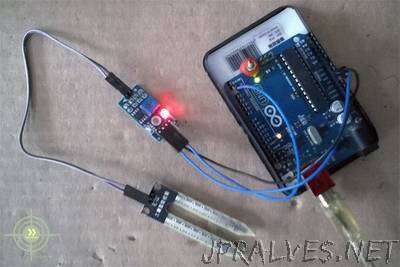
“In this article, we are going to interface a Soil moisture sensor FC-28 with Arduino. This sensor measures the volumetric content of water inside the soil and gives us the moisture level as output. The sensor is equipped with both analog and digital output, so it can be used in both analog and digital mode. In this article, we are going to interface the sensor in both modes. So lets begin our tutorial on interfacing Arduino and Soil moisture sensor.
Working of Sensor The soil moisture sensor consists of two probes which are used to measure the volumetric content of water. The two probes allow the current to pass through the soil and then it gets the resistance value to measure the moisture value. When there is more water, the soil will conduct more electricity which means that there will be less resistance. Therefore, the moisture level will be higher. Dry soil conducts electricity poorly, so when there will be less water, then the soil will conduct less electricity which means that there will be more resistance. Therefore, the moisture level will be lower.
This sensor can be connected in two modes; Analog mode and digital mode. First, we will connect it in Analog mode and then we will use it in Digital mode. Specifications The specifications of the soil moisture sensor FC-28 are as follows Input Voltage 3.3 5V Output Voltage 0 4.2V Input Current 35mA Output Signal
Both Analog and Digital Pin Out Soil Moisture Sensor The soil Moisture sensor FC-28 has four pins VCC: For power A0: Analog output D0: Digital output GND: Ground
The Module also contains a potentiometer which will set the threshold value and then this threshold value will be compared by the LM393 comparator. The output LED will light up and down according to this threshold value.”
